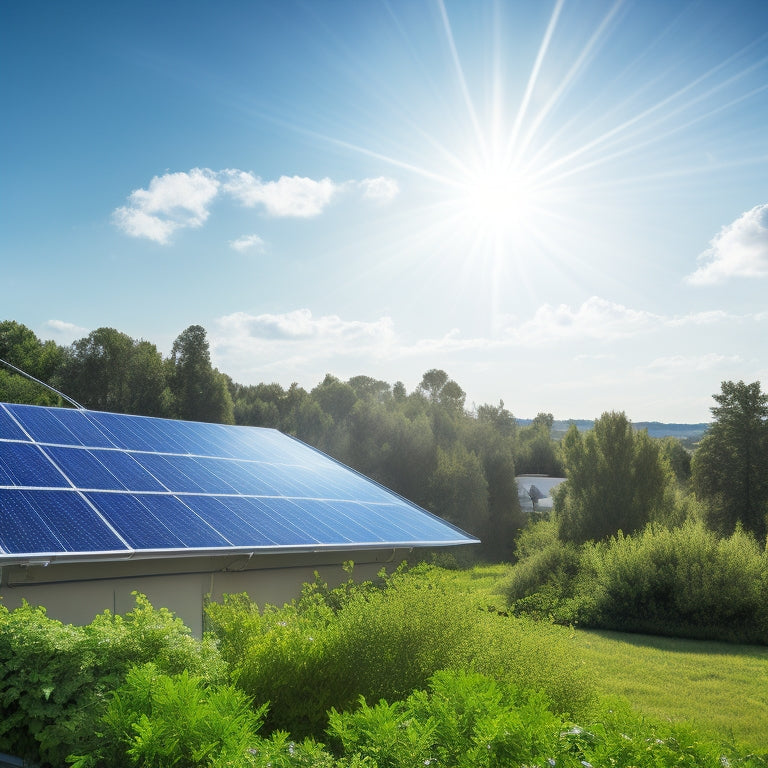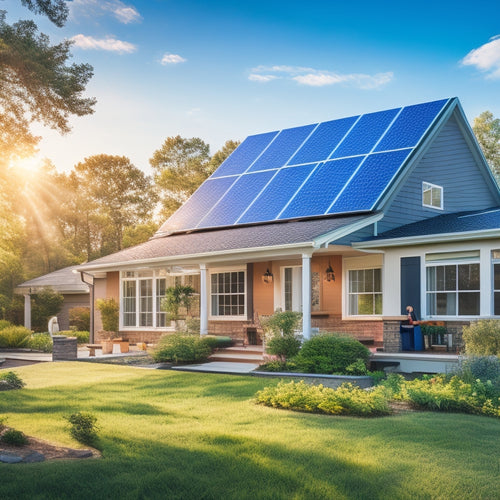
Calculate Your Solar Panel ROI in 10 Easy Steps
Share
You're looking to calculate your solar panel ROI in 10 easy steps. To start, assess your energy consumption by reviewing past utility bills and tracking your energy usage in real-time. Then, evaluate your roof's solar potential by analyzing its size, orientation, and shading. Next, calculate the system size and cost based on your energy needs and solar potential. Don't forget to research local incentives and rebates to maximize your savings. By following these steps, you'll be well on your way to calculating your solar panel ROI and making an informed investment decision. And that's just the beginning of your journey to going solar.
Key Takeaways
• Determine your current energy usage to calculate the required solar panel system size and cost.
• Research local incentives and rebates to reduce the upfront cost of the solar panel system.
• Estimate the energy savings over time based on your current energy usage and the system's energy output.
• Calculate the ROI by comparing the system's cost to the long-term energy savings and potential tax credits.
• Consider financing options and evaluate the compatibility of the investment with your long-term financial goals and priorities.
Determine Your Energy Consumption
To accurately calculate your solar panel ROI, you need to start by determining your energy consumption. This typically ranges from 500 to 1,000 kilowatt-hours (kWh) per month for an average American household. You can do this by reviewing your past utility bills to understand your energy usage patterns.
Consider investing in home automation systems, energy meters, or smart plugs to track your energy consumption in real-time. This data will help you identify areas of inefficiency and optimize your energy usage.
Assess Your Roof's Solar Potential
Your roof's solar potential depends on its size, orientation, and shading, so you'll need to assess these factors to determine how much energy you can harness from the sun.
Start by evaluating your roof's orientation: is it south-facing, east-facing, or west-facing? A south-facing roof receives the most direct sunlight, while east- and west-facing roofs receive indirect sunlight.
Next, conduct a shading analysis to identify any obstacles, such as trees or neighboring buildings, that might block sunlight.
Consider the time of day and year to determine the best placement and number of solar panels needed to maximize energy production.
Calculate System Size and Cost
You'll need to calculate the system size and cost based on your roof's solar potential and energy needs, considering factors like panel efficiency, inverter capacity, and local building codes. This will help you determine the best system design for your property.
| System Design Factors | Impact on Cost |
|---|---|
| Panel Efficiency | Higher efficiency panels cost more, but require less space |
| Inverter Capacity | Larger inverters increase cost, but handle more power |
| Local Building Codes | Compliance with codes may add to overall system cost |
| System Size (kW) | Larger systems cost more, but provide more energy |
Evaluate Local Incentives and Rebates
Now that you've determined the ideal system size and cost, it's time to explore the financial benefits that can offset your investment, starting with local incentives and rebates that can greatly reduce your upfront costs.
Research State Policies, such as tax credits, property tax exemptions, and sales tax exemptions, which can greatly impact your ROI. Additionally, investigate Utility Partnerships, like net metering programs, that can provide credits for excess energy generated.
Look into local government and utility company websites to find available incentives and rebates in your area. Take note of the specific requirements and deadlines for each incentive, as they can vary.
Estimate Energy Savings Over Time
To estimate your solar panel system's ROI, you need to calculate how much energy you'll save over time. Start by determining your daily energy usage, which will help you understand how much energy you'll offset with solar power.
From there, you can project your long-term savings based on your reduced energy consumption.
Daily Energy Usage
Your daily energy usage pattern plays a significant role in estimating the energy savings you can expect from installing solar panels over time. To accurately calculate your energy savings, you'll need to understand your daily energy usage habits.
Start by conducting an energy audit to identify areas of high energy consumption. Take note of your appliance usage, including smart appliances that provide real-time energy usage data.
Track your energy usage patterns over a week or month to get a thorough picture. This data will help you determine how much energy you can offset with solar power and estimate the energy savings you can expect.
Long-Term Savings
By analyzing your daily energy usage patterns, you can estimate the long-term energy savings potential of your solar panel installation over time. This is essential in determining the economic benefits of going solar.
As you generate your own clean energy, you'll reduce your reliance on the grid and lower your utility bills. Over the system's lifespan, these savings can add up, providing a significant return on your investment.
A sustainable future isn't only environmentally friendly but also economically savvy. By investing in solar, you're securing a stable energy future while enjoying long-term savings. These savings can be substantial, making solar a wise financial decision.
Calculate Your Payback Period
Determining your payback period helps you understand how long it takes for your solar panel investment to break even. This is vital in evaluating the viability of your investment.
To calculate your payback period, you'll need to create an investment timeline, outlining your upfront costs, ongoing expenses, and expected savings.
Based on your financial projections, you can estimate how long it'll take for your solar panels to generate enough savings to offset your initial investment.
By doing so, you'll have a clear understanding of when you can expect to see a return on your investment.
This calculation will give you a better grasp of your solar panel investment's financial performance, allowing you to make informed decisions about your energy future.
Analyze Your ROI and Breakeven Point
Now that you've established your payback period, you can analyze your ROI and breakeven point to gain a deeper understanding of your solar panel investment's financial performance.
To do this, calculate your Net Present Value (NPV) by discounting your Cash Flow Projections over the system's lifespan. This will give you a clear picture of your investment's profitability.
Next, determine your breakeven point, which is the point at which your NPV equals zero. This is important in understanding when your investment will start generating profits.
Consider Financing and Funding Options
You have several financing and funding options available when investing in a solar panel system, including government incentives, loans, and power purchase agreements. These options can help make your solar panel investment more affordable and increase your ROI. Here are some popular financing and funding options to explore:
| Option | Description | Benefits |
|---|---|---|
| Government Incentives | Federal and state tax credits, grants | Reduces upfront cost, increases ROI |
| Green Bonds | Environmentally friendly bonds for sustainable projects | Low-interest rates, long-term financing |
| Crowdfunding | Online platforms for community-supported funding | Low costs, community engagement |
| Power Purchase Agreements | Third-party financing, fixed energy rates | Predictable energy costs, no upfront cost |
Review and Refine Your ROI Calculation
Having your financing and funding options in place, it's essential to revisit and refine your ROI calculation to guarantee it accurately reflects the true costs and benefits of your solar panel investment.
You've gathered a wealth of data, but it's easy to overlook important details or make ROI mistakes that can skew your financial projections. Take a step back to review your calculations, ensuring you're accounting for all expenses, incentives, and savings.
Double-check your math, and consider seeking input from a financial advisor or industry expert. By refining your ROI calculation, you'll gain a clearer understanding of your solar panel investment's true potential and make informed decisions about your energy future.
Make an Informed Investment Decision
With a refined ROI calculation in hand, it's time to weigh the pros and cons of investing in solar panels, considering factors beyond just financial returns.
As you deliberate, consider your risk tolerance: are you comfortable with the upfront costs and potential maintenance needs?
Align your decision with your financial goals: are you prioritizing long-term savings or immediate returns?
Weigh the benefits of reduced carbon emissions, increased property value, and potential tax incentives against the costs.
Assess how solar panels fit into your overall financial strategy, and whether the investment aligns with your values and priorities.
Frequently Asked Questions
Can I Install Solar Panels on a Rented Property?
"Take the bull by the horns and consider installing solar panels on your rented property, but don't jump the gun - you'll need to review your rental agreements and get your landlord's permission first."
How Long Does a Typical Solar Panel System Last?
You can expect a typical solar panel system to last around 25-30 years, with some manufacturers offering warranty coverage for up to 40 years; regular maintenance schedules will help guarantee peak performance and extend its lifespan.
Are Energy Storage Systems Worth the Additional Cost?
"Like a Swiss watch, your energy storage system hums along, but are the added costs worth it? You'll need to weigh battery maintenance and potential system upgrades against the benefits, considering your unique energy needs and budget constraints."
Can Solar Panels Be Installed on a Metal Roof?
You're wondering if solar panels can be installed on a metal roof. It's possible, but you'll need to take into account the metal type and roof age. For example, standing-seam metal roofs are ideal, while older roofs might require additional structural support.
Do Solar Panels Work During a Power Outage?
"Sorry to burst your bubble, but during a power outage, your shiny new solar panels won't provide backup power - unless you have a grid connection with a battery storage system, you'll be left in the dark."
Related Posts
-

Evaluating Solar Power Options for Businesses
Evaluating solar power options for your business can greatly reduce energy costs and enhance sustainability. Start by...
-

Energy-Efficient Lighting Solutions for Sustainable Buildings
For sustainable buildings, energy-efficient lighting solutions, like LEDs, offer multiple benefits. These bulbs last ...
-

Solar Energy Grants and Incentives for Homeowners
Maneuvering solar energy grants and incentives is essential for reducing your installation costs. You can benefit fro...


